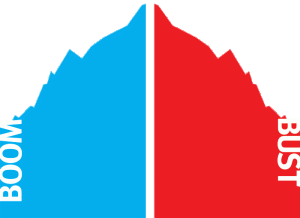Let us now proceed to Chapter 20, Section 9 of Human Action. The central idea discussed under this section is about the impact of business cycle on the market.
Reading the previous post should make it clear by now that increase in money supply promoting credit expansion is the real cause for business fluctuations. These fluctuations are popularly known as “boom” and “bust” of business.
Mises appropriately describes the “boom” aspect of business cycle as “delusive prosperity.” It is an economic illusion not based on real data. It is an artificial wealth. No corresponding increase in production is taking place with the increase in money supply. This increase in money supply also called as inflation is mistakenly identified with economic progress. Such an artificial boom therefore is already doomed from its very source. It is the real culprit. It is the disease caused both by inflation and credit expansion.
The “bust” side of business is dreaded by politicians, bankers, economists, and the public. But in reality, economic depression is the way of the free market to restore health back into the economy. It is an act of economic recovery. Mises states: “we must call the boom retrogression and the depression progress” (p. 575).
The business cycle has several serious impacts on the market. In reality, business boom is a waste of economic resources through bad investments and decreases the quantity of goods through overconsumption. Its inescapable outcome is impoverishment.
The material impoverishment that follows after economic prosperity is a little consequence in comparison to the mental and psychological damages resulting from economic depression. People would turn despondent, dispirited, and frustrated. People would lose their “self-confidence and the spirit of enterprise to such an extent that they even fail to take advantage of good opportunities” (p. 578). “The more optimistic they were under the illusory prosperity of the boom, the greater is their despair and their feeling of frustration” (p. 576).
The unthinkable part among the impact of business cycle in the market is the public longing for more inflation and credit expansion. For Mises, this proves the incorrigibility of the people. For the public, “more inflation and more credit expansion are the only remedy against the evils which inflation and credit expansion have brought about” (pp. 576-577).
A popular argument in favor of more credit expansion upholds that more credit would enable the entrepreneurs to expand production, the unemployed to find jobs, and consumers to purchase products. It is argued that refraining from more credit would sink the economy into a prolonged depression. It is an erroneous analysis. In fact, this longing for more credit expansion only interrupts and prolongs the curative process resulting from depression. It could create a new boom resulting to deeper economic depression. This failure to learn the lesson from depression would keep the old story of boom and bust in repeating itself.
The prevailing erroneous opinion and response to economic depression is a result of the influence of the nonmonetary explanations of the trade cycle and the advocates of inflation and credit expansion. Only the monetary credit theory has clarified the notion about the neutrality of money and has provided also reasonable explanation about the cause of business cycle.
However, those motivated by political bias would certainly persist in nonmonetary explanation of the cyclical trade fluctuations despite of evidence. Mises identified them as the Marxians, non-Marxian socialists, and the interventionists.
The Marxians uphold that business boom and bust are inherent flaws in capitalism. The primary concern of non-Marxian socialists and interventionists is to exploit the alleged weakness of free market in order to destroy it and establish statist omnipotence. As a whole, the nonmonetary theorists of the business cycle receive inspiration from the Marxian and explain the trade cyclical fluctuations in terms of “disproportionality in the size of investments made in various branches of industry” (p. 582). They see it as inherent contradiction within the free market economy.
To explain these disproportionality doctrines in detail is the subject of the next post.

No comments:
Post a Comment